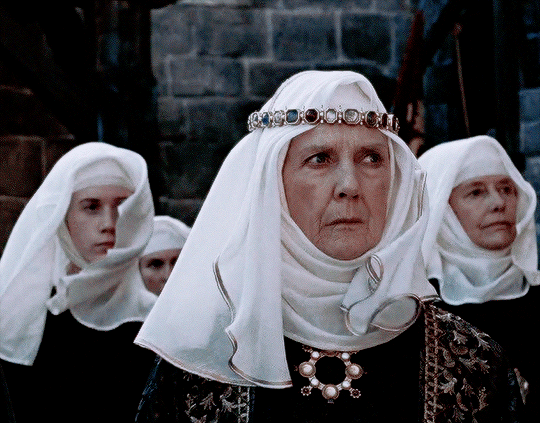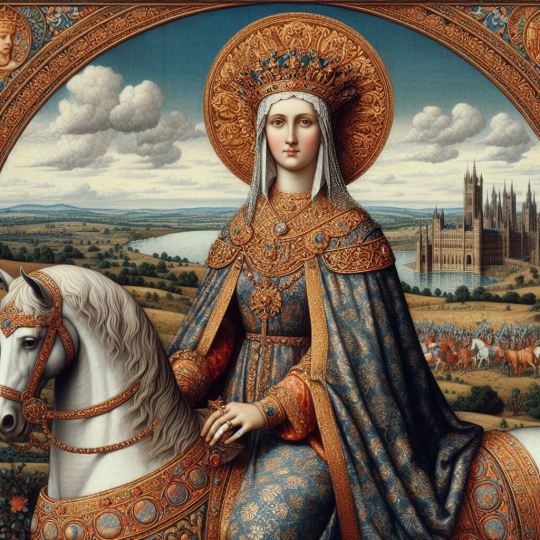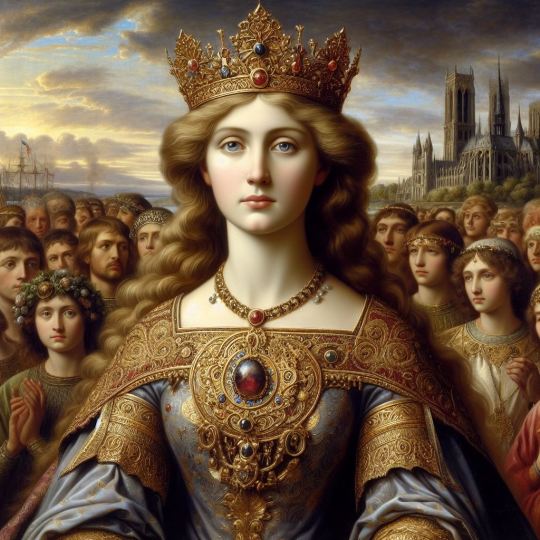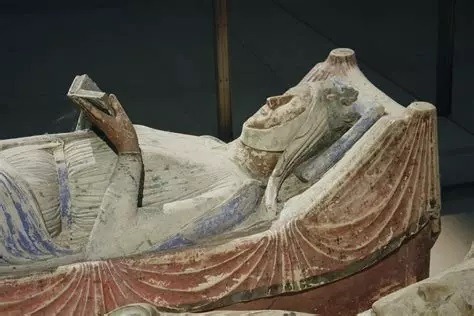#aliénor d'aquitaine
Photo


#same
#eleanor of aquitaine#perioddramaedit#aliénor d'aquitaine#robin hood 2010#period drama#eileen atkins#our gifs#our creations#need more medieval period dramas#*with* accurate headdresses#there is only so few representations
118 notes
·
View notes
Text
"Tu as raison, je ne veux pas te bercer d’illusions, Louis : ce n’est pas toi que je défends... C’est ma couronne !" Aliénor d'Aquitaine.



Citation de Damien Sirven, Aliénor d'Aquitaine, Les reines de Sang, T.6, 2017.
Image par IA.
2 notes
·
View notes
Text
Capétiens vs Plantagenêts: a matter of suzerainty.
It was also his position as suzerain which gave Louis VII the chance of interfering in and inflaming the quarrels which raged in the Angevin family. This was an effective means of weakening his great antagonist. Henry II and Eleanor produced a large family, and reared four of their sons to the age at which custom demanded that they should be provided for. Their eldest son Henry was granted Normandy in October 1160 and was associated with his father on the throne of England in 1170. Richard was given Aquitaine in 1169 and Geoffrey Brittany in 1175. John, the youngest child of Henry and Eleanor, was not old enough to be entrusted with any estates until the very last years of his father's reign, and by the time he came of age all the available lands had been given away. As Duke of Normandy, Duke of Aquitaine, Count of Poitiers, the sons of Henry II came to perform homage to the King of France and became his men. It was in vain that Henry II sought to utilise the Norman procedure of pariage to maintain the unity of his continental territories in favour of his eldest son, the "Young King" Henry. (Under pariage the eldest son succeeded to all the heritable property and was alone answerable for it to the suzerain; each of his brothers received a share, but held it of him). This device could not be put into full operation in Aquitaine, which was not part of Henry's heritage but Eleanor's. And when she granted it to Richard, he owed homage not to his father or his eldest brother, but to the King of France. The Young King Henry had done homage as Duke of Normandy to Louis VII in October 1160. When he repeated his homage in 1170 it was made to embrace Anjou, Maine, and Brittany as well. At the same time Richard did homage to Louis for Aquitaine.
It is true that in 1174 Henry II compelled his sons to perform homage to him after their rebellion, but this new homage did not necessarily annul their homages to the King of France. Henry II himself had done homage to Louis VII in 1151 and again in 1169, and was to perform it yet again to Louis's successor, Philip Augustus, in 1180. Thus throughout the conflict between Louis VII and Henry II the French king's suzerainty was affirmed and recognised. This did not save Louis from defeats at his vassal's hands. Nevertheless, to judge from the Toulouse affair in 1159, Louis' suzerainty occasionally cramped Henry's style, and put him in the wrong in the eyes of contemporaries, including the barons of his continental fiefs. To play the rebel vassal was hardly prudent for a king when many of his own vassals were rebelliously inclined. It was not that the idea of rebellion itself shocked feudal society. On the contrary, it was one of the legitimate courses open to a vassal needing to safeguard his rights against the encroachments of his suzerain. But in the disputes between Louis VII and Henry II, Henry was the law-breaker as well as the vassal in revolt. For his rebelliousness against an impeccable suzerain there could be no justification.
It may be objected that Louis VII was constantly intriguing with Eleanor of Aquitaine and with Henry II's sons. But after all Eleanor, as Duchess of Aquitaine, was herself a royal vassal. Two of Henry's sons had done homage to Louis. Another, Geoffrey, by dint of his father's vassalage, was the French king's rear-vassal. And the king had, as suzerain, not merely the right but the duty to concern himself with the welfare and harmony of his great vassal's family, to ensure that a proper settlement was made on the sons. It would be unfair to accuse Louis of hypocrisy; nor did Henry ever complain that the French king was making trouble in his family. Louis' own grievances against Henry were many and varied, and Henry never made a serious effort to deny their validity.
Thus from 1154 to 1180 Henry II had the appearance of a vassal engaged in unjustifiable revolt against his suzerain. This line of conduct undermined his own position. It constantly reminded the baronage of the Angevin fiefs that the King of France was Henry's suzerain- if only because his suzerainty was so often invoked. And it helped to prevent the fusion of the individual elements of the Angevin empire on the continent. Provincial separation, already too strong for Angevin rule to subdue, was reinforced.
Robert Fawtier- The Capetian Kings of France
#xii#robert fawtier#the capetian kings of france#louis vii#henry ii of england#aliénor d'aquitaine#henry the young king#richard the lionheart#geoffrey plantagenêt#john lackland#jean sans terre
7 notes
·
View notes
Text
I am making progress in my Merlin fic !
2 notes
·
View notes
Photo

"Pop-Aliénor" de Piko Paseos
Apprécié par beaucoup d’habitants, par des commerçants qui lui demandent d’habiller leur façade de ses œuvres, son travail a semble-t-il aussi tapé dans l’œil de la mairie qui lui a proposé de réaliser un collage monumental en hommage à Aliénor d’Aquitaine, reine de France puis d’Angleterre, mère de Richard Cœur de Lyon et figure emblématique de Poitiers, dont on célèbre cet été les 900 ans de la naissance.

(via Le plasticien Piko Paseos célèbre Aliénor d’Aquitaine avec un collage sur les marches du Palais des Ducs à Poitiers)
8 notes
·
View notes
Video
youtube
J’ai enfin pu regarder “Le lion en hiver” hier soir et c’était top. Surprenant, sombre, et avec la génialissime Katharine Hepburn dans le rôle d’Aliénor d’Aquitaine, 60 ans, toujours aussi implacable, intelligente, et pleine de ressources.
Un peu déçue qu’ils n’aient pas filmé à Chinon mais j’ai cru comprendre que la zone était déjà devenue trop moderne pour que ça paraisse crédible dans le film. Pendant quelques heures, je me suis crue au 12ème siècle.
1 note
·
View note
Text
"Eleanor's conduct was repeatedly criticised by church elders, particularly Bernard of Clairvaux and Abbot Suger, as indecorous. The king was madly in love with his beautiful and worldly bride, however, and granted her every whim, even though her behaviour baffled and vexed him. Much money went into making the austere Cité Palace in Paris more comfortable for Eleanor's sake.
(...) The marriage was annulled on 21 March 1152 on the grounds of consanguinity within the fourth degree. Their daughters were declared legitimate, custody was awarded to Louis, and Eleanor's lands were restored to her.
As soon as the annulment was granted, Eleanor became engaged to her third cousin Henry, Duke of Normandy. The couple married on Whitsun, 18 May 1152. Henry and Eleanor became king and queen of England in 1154. They had five sons and three daughters. However, Henry and Eleanor eventually became estranged. Henry imprisoned her in 1173 for supporting the revolt of their eldest son, Henry the Young King, against him. She was not released until 6 July 1189, when her husband died and their third son, Richard I, ascended the throne. As queen dowager, Eleanor acted as regent while Richard went on the Third Crusade. She lived well into the reign of her youngest son, John.'
#Eleanor of Aquitaine#Aliénor d'Aquitaine#France#United Kingdom#ruler#women#history#interesting ladies on wikipedia
1 note
·
View note
Text

Aliénor d'Aquitaine, née vers 1122 ou 1124, et morte à Poitiers le 31 mars ou le 1er avril 1204, a été tour à tour reine de France, puis reine d'Angleterre. Aliénor d'Aquitaine vécu 82 ans.
10 notes
·
View notes
Text

Katharine Hepburn et Peter O'Toole dans "Le Lion en Hiver" d'Anthony Harvey (1968) - d'après la pièce de théâtre éponyme de James Goldman (1966) évoquant les intrigues menées autour de la succession d'Henri II d'Angleterre (1133-1189) avec de son épouse Aliénor d'Aquitaine et leurs trois fils Richard Coeur de Lion", Jean Sans Terre et Geoffroy II de Bretagne - décembre 2023.
6 notes
·
View notes
Text
"A woman's heart is just as capable of leading an empire as a man's." M.Aurell, Aliénor d'Aquitaine, 2020.
"Le cœur d’une femme est tout aussi capable de diriger un empire que celui d’un homme."

Aliénor d'Aquitaine par Frederick Sandys,1858, musée national de Cardiff.
0 notes
Text
Blanche, Marguerite, and Queenship
Blanche's actions as queen dowager amount to no more than those of her grandmother and great-grandmother. A wise and experienced mother of a king was expected to advise him. She would intercede with him, and would thus be a natural focus of diplomatic activity. Popes, great Churchmen and great laymen would expect to influence the king or gain favour with him through her; thus popes like Gregory IX and Innocent IV, and great princes like Raymond VII of Toulouse, addressed themselves to Blanche. She would be expected to mediate at court. She had the royal authority to intervene in crises to maintain the governance of the realm, as Blanche did during Louis's near-fatal illness in 1244-5, and as Eleanor did in England in 1192.
In short, Blanche's activities after Louis's minority were no more and no less "co-rule" than those of other queen dowagers. No king could rule on his own. All kings- even Philip Augustus- relied heavily on those they trusted for advice, and often for executive action. William the Breton described Brother Guérin as "quasi secundus a rege"- "as if second to the king": indeed, Jacques Krynen characterised Philip and his administrators as almost co-governors. The vastness of their realms forced the Angevin kings to rely even more on the governance of others, including their mothers and their wives. Blanche's prominent role depended on the consent of her son. Louis trusted her judgement. He may also have found many of the demands of ruling uncongenial. Blanche certainly had her detractors at court, but she was probably criticsed, not for playing a role in the execution of government, but for influencing her son in one direction by those who hoped to influence him in another.
The death of a king meant that there was often more than one queen. Blanche herself did not have to deal with an active dowager queen: Ingeborg lived on the edges of court and political life; besides, she was not Louis VIII's mother. Eleanor of Aquitaine did not have to deal with a forceful young queen: Berengaria of Navarre, like Ingeborg, was retiring; Isabella of Angoulême was still a child. But the potential problem of two crowned, anointed and politically engaged queens is made manifest in the relationship between Blanche and St Louis's queen, Margaret of Provence.
At her marriage in 1234 Margaret of Provence was too young to play an active role as queen. The household accounts of 1239 still distinguish between the queen, by which they mean Blanche, and the young queen — Margaret. By 1241 Margaret had decided that she should play the role expected of a reigning queen. She was almost certainly engaging in diplomacy over the continental Angevin territories with her sister, Queen Eleanor of England. Churchmen loyal to Blanche, presumably at the older queen’s behest, put a stop to that. It was Blanche rather than Margaret who took the initiative in the crisis of 1245. Although Margaret accompanied the court on the great expedition to Saumur for the knighting of Alphonse in 1241, it was Blanche who headed the queen’s table, as if she, not Margaret, were queen consort. In the Sainte-Chapelle, Blanche of Castile’s queenship is signified by a blatant scattering of the castles of Castile: the pales of Provence are absent.
Margaret was courageous and spirited. When Louis was captured on Crusade, she kept her nerve and steadied that of the demoralised Crusaders, organised the payment of his ransom and the defence of Damietta, in spite of the fact that she had given birth to a son a few days previously. She reacted with quick-witted bravery when fire engulfed her cabin, and she accepted the dangers and discomforts of the Crusade with grace and good humour. But her attempt to work towards peace between her husband and her brother-in-law, Henry III, in 1241 lost her the trust of Louis and his close advisers — Blanche, of course, was the closest of them all - and that trust was never regained. That distrust was apparent in 1261, when Louis reorganised the household. There were draconian checks on Margaret's expenditure and almsgiving. She was not to receive gifts, nor to give orders to royal baillis or prévôts, or to undertake building works without the permission of the king. Her choice of members of her household was also subject to his agreement.
Margaret survived her husband by some thirty years, so that she herself was queen mother, to Philip III, and was still a presence ar court during the reign of her grandson Philip IV. But Louis did not make her regent on his second, and fatal, Crusade in 1270. In the early 12605 Margarer tried to persuade her young son, the future Philip III, to agree to obey her until he was thirty. When Philip told his father, Louis was horrified. In a strange echo of the events of 1241, he forced Philip to resile from his oath to his mother, and forced Margaret to agree never again to attempt such a move. Margaret had overplayed her hand. It meant that she was specifically prevented from acting with those full and legitimate powers of a crowned queen after the death of her husband that Blanche, like Eleanor of Aquitaine, had been able to deploy for the good of the realm.
Why was Margaret treated so differently from Blanche? Were attitudes to the power of women changing? Not yet. In 1294 Philip IV was prepared to name his queen, Joanna of Champagne-Navarre, as sole regent with full regal powers in the event of his son's succession as a minor. She conducted diplomatic negotiations for him. He often associated her with his kingship in his acts. And Philip IV wanted Joanna buried among the kings of France at Saint-Denis - though she herself chose burial with the Paris Franciscans. The effectiveness and evident importance to their husbands of Eleanor of Provence and Eleanor of Castile in England led David Carpenter to characterise late thirteenth-century England as a period of ‘resurgence in queenship’.
The problem for Margaret was personal, rather than institutional. Blanche had had her detractors at court. It is not clear who they were. There were always factions at courts, not least one that centred around Margaret, and anyone who had influence over a king would have detractors. They might have been clerks with misgivings about women in general, and powerful women in particular, and there may have been others who believed that the power of a queen should be curtailed, No one did curtail Blanche's — far from it. By the late chirteenth century the Capetian family were commissioning and promoting accounts of Louis IX that praise not just her firm and just rule as regent, but also her role as adviser and counsellor — her continuing influence — during his personal rule. As William of Saint-Pathus put it, because she was such a ‘sage et preude femme’, Louis always wanted ‘sa presence et son conseil’. But where Blanche was seen as the wisest and best provider of good advice that a king could have, a queen whose advice would always be for the good of the king and his realm, Margaret was seen by Louis as a queen at the centre of intrigue, whose advice would not be disinterested.
Surprisingly, such formidable policical players at the English court as Simon de Montfort and her nephew, the future Edward I, felt that it was worthwhile to do diplomatic business through Margaret. Initially, Henry III and Simon de Montfort chose Margaret, not Louis, to arbitrate between them. She was a more active diplomat than Joinville and the Lives of Louis suggest, and probably, where her aims coincided with her husband’s, quite effective.
To an extent the difference between Blanche’s and Margaret’s position and influence simply reflected political reality. Blanche was accused of sending rich gifts to her family in Spain, and advancing them within the court. But there was no danger that her cultivation of Castilian family connections could damage the interests of the Capetian realm. Margaret’s Provençal connections could. Her sister Eleanor was married to Henry III of England. Margaret and Eleanor undoubtedly attempted to bring about a rapprochement between the two kings. This was helpful once Louis himself had decided to come to an agreement with Henry in the late 1250s, but was perceived as meddlesome plotting in the 1240s. Moreover, Margaret’s sister Sanchia was married to Henry's younger brother, Richard of Cornwall, who claimed the county of Poitou, and her youngest sister, Beatrice, countess of Provence, was married to Charles of Anjou. Sanchia’s interests were in direct conflict with those of Alphonse of Poitiers; and Margaret herself felt that she had dowry claims in Provence, and alienated Charles by attempting to pursue them. Indeed, her ill-fated attempt to tie her son Philip to her included clauses that he would not ally himself with Charles of Anjou against her.
Lindy Grant- Blanche of Castile, Queen of France
#xiii#lindy grant#blanche of castile queen of france#blanche de castille#grégoire ix#innocent iv#raymond vii de toulouse#aliénor d'aquitaine#louis ix#philippe ii#guérin#louis viii#marguerite de provence#aliénor de provence#alphonse de poitiers#henry iii of england#philippe iii#jeanne i de navarre#philippe iv#simon de montfort#edward i of england#jean de joinville#sancia de provence#béatrice de provence#charles i d'anjou
15 notes
·
View notes
Text
youtube
#aliénor d'aquitaine#katharine hepburn#a lion in winter#bbc merlin#one shot : merlin at aliénor's court#Youtube
1 note
·
View note
Text

Louis VII:
First husband of Aliénor d'Aquitaine.
Philippe:
Won the Battle of Bouvines. Overall a pretty cool dude.
2 notes
·
View notes
Text
Il y a des médiévistes ici ? J’ai des petites questions à vous poser sur le 12ème siècle et Aliénor d’Aquitaine.
#moyen-âge#middle ages#Aliénor d'Aquitaine#eleanor of aquitaine#aquitaine#vin de bordeaux#langue d'oc
1 note
·
View note
Note
Hey there, I love your work ❤️
Just wanted to ask you which movie or series you used for your Aliénor d'Aquitaine gifs? Thank you in advance!
hi anon, thank you so much <3
I use multiple media for eleanor. mainly from the documentary ‘britains bloodiest dynasty/crown’, ‘robin hood (2010)’ and sometimes from the tv series ‘camelot (2011)’.
hope that helps :)
2 notes
·
View notes